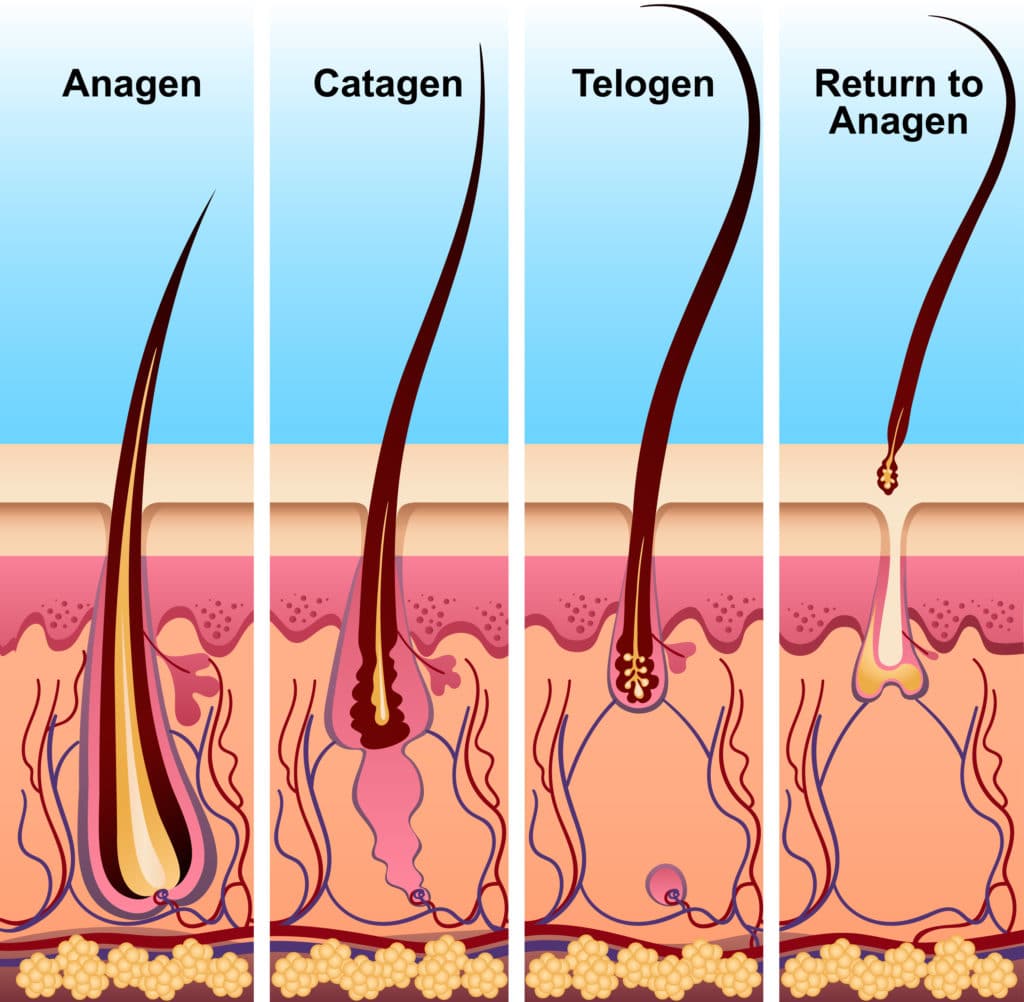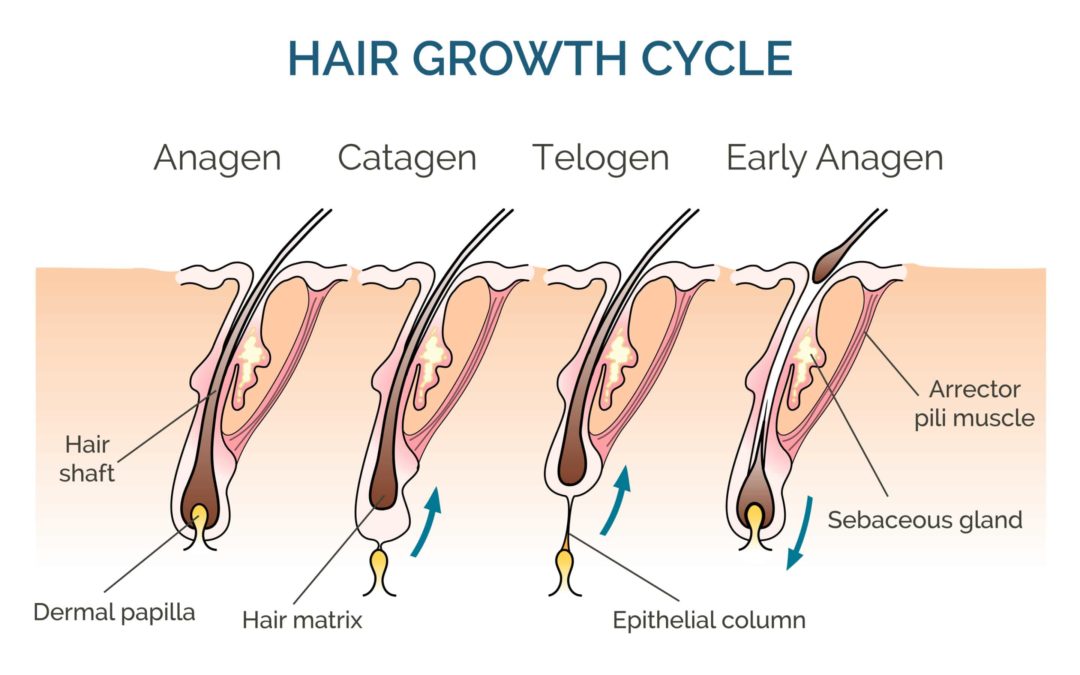There is no single kind of hair loss. It can mean many different things to many different people, and it progresses over time from minimal to severe. The hair loss process is a cycle, starting with one catalyst and growing to encompass (in some cases) your entire head. In this article, let’s look at the hair growth cycle, and its relation to hair loss’s symptoms and causes, and some of the more notable forms of hair loss.
Table of Contents
- 1
- 1.1 What is Alopecia?
- 1.2 Aside From Age, What Can Cause Hair Loss?
- 1.3 Do You Have Hair Loss or Hair Shedding?
- 1.4 Regrowing Hair
- 1.5 Hair Growth Cycle FAQs
- 1.6 What are the three stages of the hair growth cycle?
- 1.7 How can I increase my hair growth cycle?
- 1.8 How long is the hair growth cycle?
- 1.9 Why is my hair falling out?
The Hair Growth Cycle
The hair growth cycle has three major phases: anagen, catagen and telogen–and then the cycle goes back to anagen and renews.
To begin with, let’s define a few terms: the hair follicle is what anchors the hair to your skin. A hair follicle consists of a papilla and a bulb. The papilla provides blood to the cells, and the bulb is the cells that grow the hair. The hair shaft is the hair that grows out of the follicle (generally what we consider “hair”), and it is made of a hard protein called keratin.

Anagen Phase
The beginning phase of hair growth is the anagen phase. The cells in the bulb divide and produce new hair. A single follicle is active between 2-7 years and in that time can grow as much as 30 inches of hair. After that time the follicle will become dormant. The amount of time that a hair follicle is in the anagen phase depends on a person’s age, genetics, health, nutrition, and many more factors.
The reason that hair on our arms or eyebrows don’t grow to 30 inches is because they have a very short anagen phase. Some people have a limit to how long the hair on their head will grow as well, because of the length of the anagen phase.
Catagen Phase
The second phase of growth is the catagen phase and 3% of hair is in this phase at any given time. Compared to the anagen phase, this phase is very short, often only a few weeks. During this phase, the hair stops growing and detaches from the blood supply. The hair at this stage is referred to as club hair.
Telogen Phase
The final stage of the growth cycle is the telogen phase, in which new hair begins to grow underneath the club hair. This phase lasts for about three months. At the end of this phase, the club hair will fall out to allow the new hair to grow. The average person loses 50-100 hairs a day to this process, but we have so many hairs on our heads that it’s hardly noticed. (The average human head has 100,000 hairs when it is fully healthy and growing.)
Hair Loss: Symptoms and Causes

Hair loss, otherwise known as alopecia, isn’t just a problem that affects your head (though it often does in many people). Hair loss can affect your entire body, and its effects can be temporary or permanent. Any number of things can cause hair loss, but the major players are genetics and heredity, hormonal changes, medical conditions, or simply a natural process of aging. In almost all cases, the hair loss is caused by a breakdown in the hair growth cycle.
The term “baldness” generally refers to hair loss on your scalp, rather than hair loss on other parts of your body, and genetics are the biggest cause of baldness. If you have a family history of baldness, then odds are good you’re in for it, too. There has been much written about the particular hereditary branch that leads to baldness–does it come from your father or your mother?–but the truth is that it can come from either.
Some people are content in their baldness and will let it go naturally, even shaving the scalp to make it clean and free of fuzz, while others tend to grow what they can and hold onto the hair they have. Many, particularly women, who are societally expected to have fuller hair, cover their baldness with hats or wigs. And, of course, some people choose to combat the loss of hair through the use of hair regrowth medicines and treatments.
Symptoms of Hair Loss
There are many ways that hair loss can appear–different parts of the head experience it differently–but here are a few of the most common symptoms of a disruption in the hair growth cycle.
Gradual thinning on top of the head
This is the most common type of hair loss, and most incident to age. Mens’ hair begins to recede at the hairline, or develop a patch in the back. Women’s hair also thins, but it’s more of an all-over kind of thinning. When women have a receding hairline it’s referred to as frontal fibrosing alopecia.
Learn More: Can Hair Grow Back After Thinning?
Patchy bald spots
You may lose hair in a circular area (often on the crown of the head) or in other patchy bald spots. This is often, though not always, accompanied by itching and pain before the hair falls out.
Sudden loss of hair
This can be caused by some kind of traumatic shock, either physical or emotional. In these cases the hair doesn’t simply fall out, but it loosens, so that when you comb or brush your hair the hair comes off in clumps. Fortunately, this form of hair loss is usually temporary.
Full-body hair loss
This is most often a result of a medical condition, or something related. For example, people going through chemotherapy often lose hair all over their body. Assuming the chemotherapy stops and the person regains their health, the hair will typically grow back as full as it was before.
Patches all over the scalp
This patching can be accompanied by redness, swelling, and oozing, and is usually a sign of ringworm. See professional help immediately.
What is Alopecia?
Alopecia is simply the medical term for hereditary hair loss, and the American Academy of Dermatology estimates that 80 million people in America are suffering from it to some degree.
A typical person loses between 50 and 100 hairs per day. As the typical head has over 100,000 hairs, it’s not noticeable and not something to be concerned about. When the hair growth cycle is operating normally, new hair replaces the lost hair and you’ll never even realize that it’s being lost and replaced, over and over. But when alopecia comes into the picture two things (or both) can start happening: first, you begin to lose more than your 50 to 100 hairs a day, and two, they’re not being replaced at the same rate (or even at all). This can happen gradually over many years or all at once, with hair coming out in clumps.
If you notice this abnormal, rapid hair loss, you may want to consult a doctor and make sure that there’s no underlying condition contributing to the accelerated hair loss.
Aside From Age, What Can Cause Hair Loss?
It’s not always age or heredity that are causing the hair loss, though those are the two most common factors. But here are some other things to consider:
Hormonal changes can cause hair loss (albeit temporarily). These include pregnancy, childbirth, the discontinuation of birth control pills, and menopause. These are all normal, but if you’re concerned you should definitely contact your doctor.
Medical problems can cause hair loss, and these can be more permanent. These things include thyroid disease, alopecia areata (an autoimmune disease that attacks the hair), and ringworm, as mentioned above. There are also some diseases that leave scars, including some forms of lupus, which can result in the loss of hair permanently.
There are also some medications that can lead to hair loss, which include, but are not limited to: cancer medications (including chemotherapy), high blood pressure medicine, arthritis medicine, anti-depressants, and heart medications.
Physical and emotional shock can lead to hair loss, including a death in the family, extreme changes in weight, or a high fever. There is a myth that a sudden shock can turn your hair white, but as the follicles of hair are already dead, there is no medical reason for your hair to change color. Traumatic events can cause new gray or white hairs, however.
Finally, diet can lead to hair loss, particularly a diet that is low in protein and iron.
Learn More: What Causes Hair Loss? An Overview
Do You Have Hair Loss or Hair Shedding?
As mentioned above, hair shedding is normal and you lose 50 to 100 hairs per day. But if you lose more hairs per day than this, it is a medical condition known as telogen effluvium. This is typically brought on by traumatic events such as the ones we mentioned above, but also experiencing high stress (losing a job, going through a divorce, being in an accident), undergoing an operation, or recovering from a bad illness.

Example of Telogen Effluvium Hair Loss Type
As we mentioned above, a pregnant mom can experience hair shedding for about two months after giving birth, up to about four months, but this shedding is temporary and normal.
Hair loss, on the other hand, is when something stops the hair from growing, a medical term known as anagen effluvium. This is where hereditary hair loss comes in, but also immune system problems, hairstyles that pull and stretch the hair, harsh hair-care products, and the compulsion to pull out your hair (also known as trichotillomania).
It’s important to identify the difference between hair loss and hair shedding, and most dermatologists can quickly assess the problem and root out the cause.
Regrowing Hair
In many of these cases, such as post-pregnancy, your hair will naturally grow back. This is also true of going off of certain medicines or stopping the use of harsh hair-care products. But there are many cases of both hair shedding and hair loss where the problem can be reversed. There are products on the market–some of which can be very effective, but some of which are shams–which claim to be able to regrow your hair.

One of the best ways to regrow your hair is through the use of Kiierr Laser Hair Cap. It looks like an ordinary ball cap, and is just as comfortable, but it uses individual diode lasers to restore the hair on your head–with a 93% clinical success rate. FDA-cleared, safe and effective, the laser hair cap uses the same technology that dermatologists use in their offices day-in and day-out.
The Kiierr Laser Cap comes with the hair growth bundle, including shampoo, conditioner and vitamins, all of which have been specially formulated to help your scalp regrow its own natural hair.
To learn more about the Kiierr laser cap, check out Do Laser Caps Work for Hair Loss?
Hair Growth Cycle FAQs
What are the three stages of the hair growth cycle?
The three stages of the hair growth cycle are the anagen, catagen, and telogen stages.
How can I increase my hair growth cycle?
To increase the hair growth cycle, you will want your hair follicles to remain in the anagen stage for as long as possible. A laser cap and low level light therapy can help increase the anagen stage of the hair growth cycle on your scalp.
How long is the hair growth cycle?
This depends on the person. The anagen (growth) stage of the cycle can last anywhere between 2-7 years before transitioning to the catagen and telogen stages.
Why is my hair falling out?
There can be many determining factors as to why you could be losing your hair. If you are experiencing hair loss, it means that your hair is spending more time in the telogen stage than the anagen stage of the hair growth cycle.









